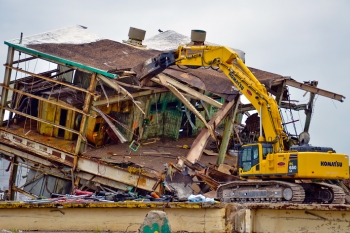Featured Project Video: Demolition work Completed at the C-410 Feed Plant Facility at the Paducah Site
Since 1990, DOE has invested $1.9 billion dollars in successful site cleanup
More than 60 years of uranium enrichment operations and support activities generated hazardous, radioactive, mixed (both hazardous and radioactive), and non-chemical (sanitary) waste. Past operations also resulted in soil, groundwater, and surface water contamination. Environmental investigations have been conducted since the 1980s to understand the extent of contamination.The goal of the Environmental Cleanup Program has been and still is to evaluate and take appropriate actions to ensure protection of human health and the environment. The Cleanup Program at Paducah supports site investigations, environmental response actions, and decommissioning and decontamination (D&D) of inactive facilities.
The goal of the Environmental Cleanup Program is to evaluate and take appropriate actions to ensure protection of human health and the environment. The Environmental Cleanup Program at Paducah supports site investigations, environmental response actions, and decontamination and decommissioning (D&D) of inactive facilities.
Since 1988, DOE has taken steps to clean up soil and ground water contamination. These actions include removing contaminated soils and treating contaminated ground water. DOE continues to monitor and make improvements to the ground water treatment system. Along with the removal of inactive facilities, DOE also implements an environmental monitoring and management program to ensure protection of human health and the environment and compliance with all applicable laws and regulations.
Cleanup Challenges
DOE established the Environmental Management (EM) program to address the hazardous substances created by past plant operations for nuclear weapons production, research, and testing activities during the Manhattan Project and Cold War. In 1992, DOE conducted an environmental investigation to determine the nature and extent of contamination at Paducah Gaseous Diffusion Plant (PGDP).
DOE uses a combination of factors to prioritize work being implemented under the EM program at PGDP:
- Regulatory expectations
- Risk-based decision making
- Compliance with other programs
- Technical considerations associated with GDP facilities
- "Mortgage"/landlord cost reduction
- Demonstrated progress toward completing the EM mission
- Future use initiatives
The 2014 annual update of the Paducah Site Management Plan set forth enforceable milestones for FY 2014, FY 2015, and FY 2016 and enforceable completion dates for cleanup activities. These activities include a series of prioritized cleanup actions, ongoing analysis to support future cleanup decisions, and eventual D&D of the gaseous diffusion plant. After completion of these cleanup activities in the future, the site will be evaluated and any additional actions will be implemented, as needed, to ensure long-term protection of human health and the environment. CERCLA 5-Year Review Evaluations will ensure that the selected actions taken to date at the PGDP remain protective of human health and the environment and continue to function as designed.
Cleanup challenges at the Paducah Site



